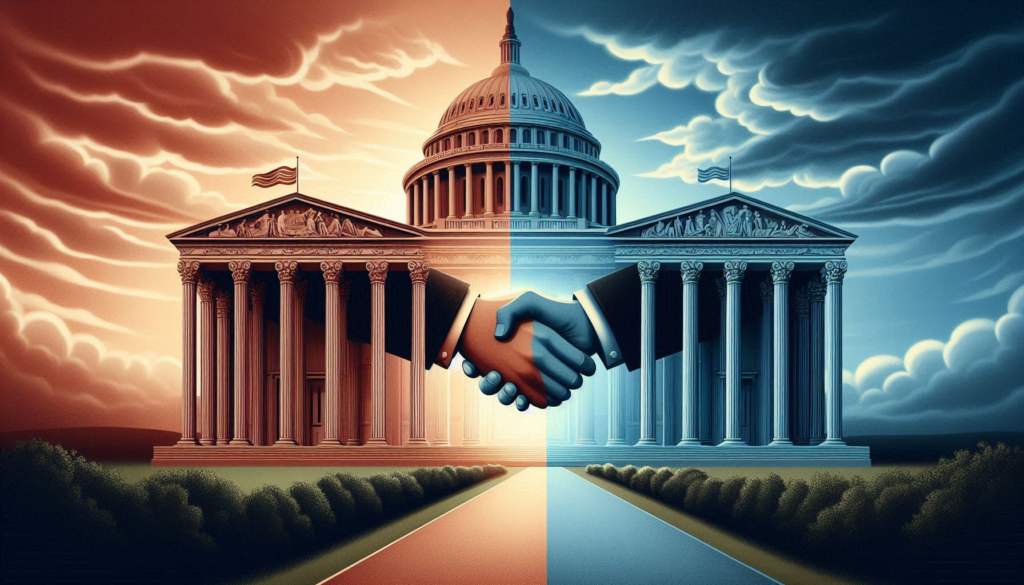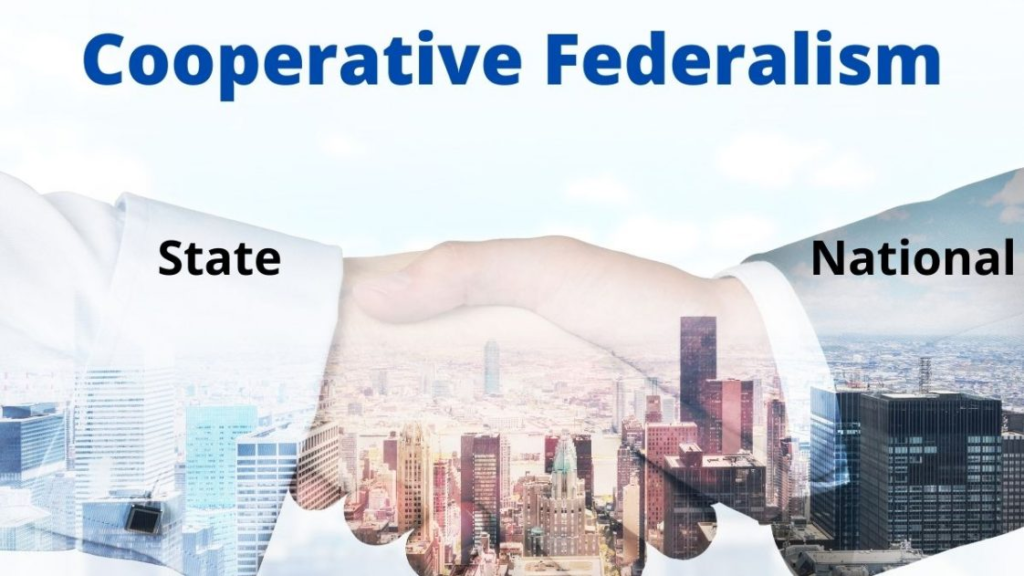
Introduction
Federalism is all about sharing power between the central government and the states, giving both sides the ability to make their own decisions in certain areas. Cooperative federalism takes that idea a step further—it’s the belief that the Centre and states should work together to solve problems and achieve common goals, rather than staying in their own separate lanes. It sounds great in theory, but in practice, it’s not always so simple. A lot of people say cooperative federalism is one of the core principles of the U.S. system, but others argue that constant political fights, party rivalries, and federal overreach often get in the way of real teamwork.
This paper looks into whether cooperative federalism is actually happening or if it’s more of an ideal we talk about than something we live by. To do that, it dives into real-world examples—like Donald Trump’s proposed 2025 tariffs—and explores how these kinds of decisions can create serious tension between the federal government and the states. By breaking down these cases, we can get a better sense of whether the system encourages true cooperation or if it’s more about competition and control.
The Concept of Cooperative Federalism
Cooperative federalism is basically the idea that the federal and state governments should work together instead of staying in their own separate lanes. It’s the opposite of dual federalism, where each level of government handles its own thing without much overlap. In a cooperative setup, both sides team up—especially in areas like healthcare, education, and infrastructure—to get things done more smoothly and consistently across the country.
This usually involves things like grants, shared policymaking, and formal agreements between the Centre and the states. Supporters of cooperative federalism say it helps create more efficient policies and ensures everyone follows the same rules, which makes programs easier to manage. A good example is the Affordable Care Act (ACA), where the federal government expanded Medicaid but needed the states to help roll it out. In return, the states got funding—but they had to play by federal rules.That’s where some pushback comes in. Critics say that these types of deals can feel like the federal government is just telling states what to do, using money as leverage. So even though it’s called “cooperation,” it doesn’t always feel like an equal partnership.
Challenges to Cooperative Federalism
Despite its theoretical appeal, cooperative federalism often breaks down due to political disagreements, fiscal constraints, and ideological divides. Some key challenges include:
Partisan Conflicts
When the federal government and state governments are controlled by opposing parties, cooperation becomes difficult. For instance, during the Obama administration, Republican-led states resisted Medicaid expansion under the ACA, arguing it was federal overreach. Similarly, Democratic states have frequently sued Republican administrations over policies like environmental deregulation and immigration enforcement.
Unfunded Mandates
The federal government often imposes policies on states without providing sufficient funding. For example, the No Child Left Behind Act (NCLB) required states to implement standardized testing but did not fully cover the costs, leading to financial strain on local education systems.
Pre-emption and Federal Overreach
Federal laws sometimes override state regulations, creating tension. The Trump administration’s efforts to roll back environmental protections, such as the Clean Power Plan, clashed with states like California, which maintained stricter emissions standards. This led to legal battles, demonstrating how federalism can become adversarial rather than cooperative.
Case Study: Trump’s Proposed 2025 Tariffs
One clear example of how tension can build between the federal government and the states is former President Donald Trump’s proposed 2025 tariffs. Back when he was in office, Trump pushed aggressive trade policies—slapping tariffs on things like Chinese goods, steel, and aluminum. He argued these moves were about protecting American jobs and industries. Now, if he gets re-elected, he’s talking about going even further—possibly adding tariffs as high as 60% on Chinese imports.

Federal vs. State Interests
Here’s where things get tricky. The federal government controls trade policy, no question—but that doesn’t mean all states are affected the same way. Some states, like Ohio and Pennsylvania, which have big manufacturing sectors, might actually benefit from these kinds of protectionist policies. But others, like California, could take a serious hit. California relies heavily on imported goods (especially electronics from China), and it also depends on exports like agricultural products—which could face retaliatory tariffs from other countries.
So while the policy is decided at the national level, the impact is very uneven across the map.
State Resistance
If Trump does go through with these new tariffs, some states are likely to push back hard. Here’s how that might play out:
- Legal Challenges: States might sue the federal government, arguing that extreme tariffs hurt interstate commerce or violate other constitutional principles.
- Economic Workarounds: States like California could try to soften the blow by building new trade relationships or offering state-level subsidies to businesses hit hardest by the tariffs.
Political Opposition: Governors in affected states might speak out publicly, criticizing the federal government’s decisions and creating serious tension between state and national leaders.
All of this shows that, despite the idea of cooperative federalism, what we often see is more like a power struggle. Instead of collaboration, trade policy becomes a battleground where states are left dealing with the consequences of decisions they had little to no say in. It’s a clear reminder that federalism in practice doesn’t always live up to the “cooperative” ideal.
COVID-19 Response
The pandemic highlighted both cooperation and conflict in federalism. While the federal government provided vaccines and relief funds, states had varying lockdowns, mask mandates, and business restrictions. Some governors (e.g., Ron DeSantis of Florida) rejected federal guidelines, while others (e.g., Gavin Newsom of California) embraced them. This patchwork response showed that federal-state collaboration was inconsistent.
Marijuana Legalization
Despite federal prohibition under the Controlled Substances Act, numerous states have legalized recreational or medical marijuana. The Biden administration has tolerated state laws, but this uneasy coexistence demonstrates a lack of true cooperation, as federal and state policies remain contradictory.
Is Cooperative Federalism a Myth?
When you look at how things actually play out, cooperative federalism often seems more like a goal than something we’ve really achieved. Sure, there are moments where the central and state governments team up—like during emergencies or when building big infrastructure projects—but most of the time, the relationship feels more competitive than cooperative. There’s usually a lot more clashing than collaborating.
A big reason for that is political polarization. These days, the divide between political parties is so intense that it makes cooperation almost impossible. If the Centre is run by one party and a state by another, they often end up fighting more than working together. We’ve seen this with things like healthcare, environmental policy, and how the COVID-19 pandemic was handled. Instead of coming together, it’s like everyone’s stuck playing the blame game.
Another issue is that states have really different economic situations. What works for a wealthy, tech-driven state like California won’t necessarily work for a state that’s more rural or struggling financially. So when the federal government tries to roll out the same policy everywhere, some states push back—hard. And it makes sense. They don’t want to follow rules that don’t match their reality. That tension makes real cooperation feel forced or fake.
And then there’s the fact that a lot of disagreements end up in court. When the Centre and the states can’t sort things out through conversation or negotiation, they take each other to court. That alone says a lot—it means that instead of talking things through, they rely on judges to settle their arguments. That’s not really what cooperation is supposed to look like.So, is cooperative federalism real? Kind of—but not in the way it’s supposed to be. The idea is there, and sometimes it works. But without real trust, communication, and flexibility, it often falls apart. Until both sides are ready to work together for real, cooperative federalism is more of a hopeful concept than something we can count on.

Is Cooperative Federalism a Reality?
After looking at everything discussed in this paper, it’s clear that cooperative federalism in the U.S. is more of a nice idea than something that actually happens consistently. Sure, there are moments when the federal and state governments work together—like on disaster relief or big infrastructure projects—but overall, the relationship is usually more about conflict than true teamwork.
Take Trump’s proposed 2025 tariffs, for example. States that would be hit hardest have little say, even though they’ll feel the biggest impact. Or look at the ongoing fights over Medicaid expansion under the Affordable Care Act—some states just flat-out refused to go along. And then there’s the situation with marijuana laws, where several states legalized it even though it’s still illegal at the federal level. These aren’t small disagreements—they show that the system often runs on competition and resistance, not cooperation.
What makes things even harder is the intense political divide, the way the federal government sometimes gives states responsibilities without funding them (aka unfunded mandates), and how often courts have to step in to settle federal-state fights. All of this shows that while cooperative federalism technically exists, it’s mostly in theory. In practice, the power struggles tend to win out.So, is cooperative federalism a total myth? Not quite. It shows up sometimes—but it’s far from being the norm. It’s more of a hopeful vision of how things could work, rather than how they actually do.
Conclusion: Cooperative Federalism – A Fragile Balance Between Myth and Reality
Cooperative federalism paints a hopeful picture: the federal and state governments working side by side to tackle big national issues while respecting each other’s space. It’s a vision built on shared responsibility and mutual respect. But as we’ve seen throughout this paper—through examples like Trump’s proposed 2025 tariffs, disagreements during COVID-19, and clashes over marijuana laws—that ideal often falls short in reality.
The Illusion of Cooperation
On paper, it looks great. Programs like Medicaid expansion or federal infrastructure grants are supposed to show how well cooperation can work. The idea is simple: the federal government offers funding and guidance, and the states help implement policies in a way that works for their local communities. But in practice, it’s messy. Medicaid expansion under the ACA became a major political battlefield, with many states flat-out refusing to participate. Environmental regulations are another example—California’s stricter emissions rules have often put it at odds with federal agencies. These cases show that instead of harmony, we often see a tug-of-war between levels of government.
Economic Policies and Federal-State Tensions
Trade policy is another area where cracks in cooperation show. While the federal government controls trade, the effects of decisions like tariffs don’t hit all states equally. Trump’s trade war and proposed 2025 tariffs are perfect examples—some manufacturing states may benefit, but others, especially those that rely on imports or exports, could suffer. When states see their economies being hurt and have no real say in the decisions, it’s no surprise they push back with lawsuits, public criticism, or their own policies. That’s not exactly teamwork.
Crisis Management and the Limits of Collaboration
The COVID-19 pandemic was a huge test for cooperative federalism—and the results were mixed at best. The federal government helped with vaccines and relief money, but states were mostly left to handle public health rules on their own. Some followed strict guidelines, others didn’t, and a few openly defied federal advice. Instead of a unified national strategy, we got a patchwork of responses shaped more by politics than by public health. It was a clear sign that even during a crisis, cooperation can quickly fall apart when there’s no clear leadership or shared strategy.
Legal and Structural Barriers
Even beyond politics, there are deeper structural issues holding back real cooperation. Unfunded mandates—where the federal government expects states to do things without providing enough money—put a serious strain on state budgets. And federal pre-emption, where federal laws override state ones, often sparks legal battles. The courts end up playing referee in disputes that probably should’ve been resolved through better communication and planning. If collaboration only happens after a lawsuit, it’s hard to call that a healthy system.
Is There a Path Forward?
If we actually want cooperative federalism to work the way it’s supposed to, some big changes are needed:
- Cutting through the political noise – Encouraging leaders to focus on problem-solving instead of party lines could go a long way.
- Fair funding – If the federal government wants states to do something, it should also help pay for it.
- Respecting local differences – Giving states more flexibility could reduce resistance and lead to better outcomes.
- Better communication – More formal ways for state and federal leaders to talk and negotiate could prevent a lot of unnecessary conflict.
Final Verdict: A System in Flux
At the end of the day, cooperative federalism is stuck somewhere between what we hope for and what we actually get. It’s not a complete myth—there are real moments of collaboration—but they’re often overshadowed by power struggles, lawsuits, and political drama. The U.S. system of federalism is constantly shifting, depending on who’s in charge and what issues are at stake. The dream of governments working together is still alive—but for now, it’s more of a work in progress than a reliable rule.
So, is cooperative federalism real? Sometimes. But until we fix the deeper issues causing the conflict, it’ll continue to be a shaky balance—flipping between cooperation and confrontation, depending on the moment.
“In the end, cooperative federalism remains less a fixed reality and more a moving target—one we keep aiming for, but rarely hit with lasting precision.”
References
https://www.drishtiias.com/mains/model-essays/cooperative-federalism-myth-or-reality
https://www.bbc.com/news/articles/cn93e12rypgo




